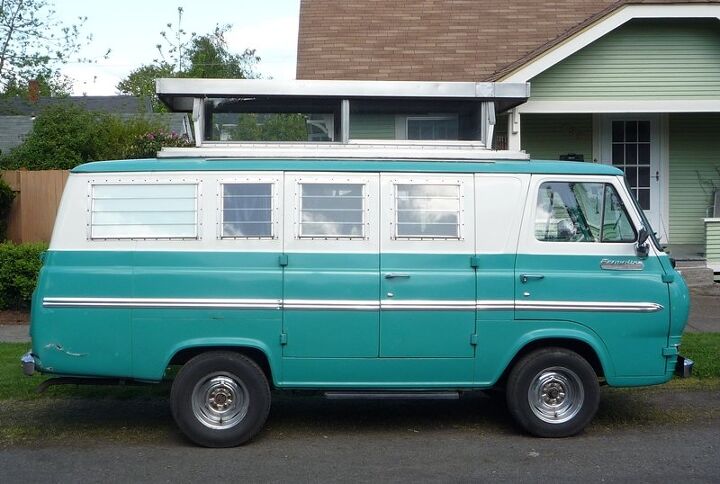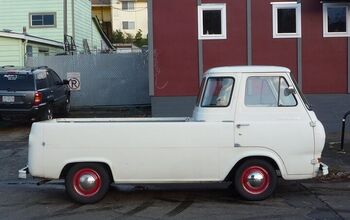Curbside Classic: 1965 Ford Econoline SuperVan Camper

This Econoline caught my eye for a number of reasons. These old bread boxes are getting scarce, even in Eugene. And this is one of the extended-body SuperVans, no less. But that’s not all; it has a trick in its hat. Watch this:
Yes, pop top campers are no big thing, but I hadn’t encountered one like this in a long while. No canvas here: the sides are rigid frames with windows all around. The clerestory camper. Being tall, and having memories of crawling around in the back of my ’68 Dodge A100 van makes this a very attractive proposition indeed.
The original Econoline appeared in 1960, in response to the growing popularity of the VW bus. Just like the Falcon it was loosely based on, the gen1 Falcon Van/Econoline was a highly pragmatic approach to building a compact van, compared to Chevy’s more ambitious rear-engined Corvair van (Corvan/Greenbrier). A box, a solid beam front axle in front and back, a wheezy little six between the seats, and no front crumple zone: a winning combination that is still being built around the world, although with independent front suspension. A timeless formula.
Despite all the enthusiasm about downsizing in 1960, the original Econoline ended up a bit smaller than what some folks, especially tradesmen and fleet buyers had in mind to carry their pipes and two by fours. I’m not exactly sure of the year it appeared, but Ford just grafted on a chunk on the rear end, and Presto: the SuperVan was born. It was a lot more primitive than what the competition did: Chevy and Dodge made extended wheelbase versions of their boxes. Ford was looking for a quick fix, since their idea of where their van was headed in a couple of years was already pretty clear.
The front seat in these vans was a memorable piece of primitiveness, even for the times. Just hunks of steel welded and screwed together. The padded dash on this one is a minor concession to safety that appeared on the later models. And the motor box made a handy third seat, nice and toasty in the winter.
The “regular” Econolines had the little Ford six, either the 144 or 170 cubic inch variety. They were both short on grunt, the 144 particularly so. But around the same time the SuperVan appeared (1965?) Ford also offered a “HeavyDuty” version, with the now venerable, but then brand new 240 CID “Big Six”, along with bigger 14″ wheels (instead of 13 inchers) and heavier springs.
I have vivid memories of riding in a HD Supervan, as a paperboy in Towson in 1965-1966. Our distributor drove one, and I’d hop in the back with stacks and stacks of Afternoon Sun papers. Old Econolines always evoke the smell of newsprint, and memories of ink-blackened hands.
I have to assume that the “long tail” Econolines probably had better traction, given the extra weight out back. The regular versions were notorious in the winter, with all that weight up front.
Getting enthusiastic about Econolines can be a bit challenging, but this one does it for me. If you’re an Econoline enthusiast, head here for the pickup version CC.

More by Paul Niedermeyer
Latest Car Reviews
Read moreLatest Product Reviews
Read moreRecent Comments
- ToolGuy Is the idle high? How many codes are behind the check engine light? How many millions to address the traction issue? What's the little triangular warning lamp about?
- Ajla Using an EV for going to landfill or parking at the bad shopping mall or taking a trip to Sex Cauldron. Then the legacy engines get saved for the driving I want to do. 🤔
- SaulTigh Unless we start building nuclear plants and beefing up the grid, this drive to electrification (and not just cars) will be the destruction of modern society. I hope you love rolling blackouts like the US was some third world failed state. You don't support 8 billion people on this planet without abundant and relatively cheap energy.So no, I don't want an electric car, even if it's cheap.
- 3-On-The-Tree Lou_BCone of many cars I sold when I got commissioned into the army. 1964 Dodge D100 with slant six and 3 on the tree, 1973 Plymouth Duster with slant six, 1974 dodge dart custom with a 318. 1990 Bronco 5.0 which was our snowboard rig for Wa state and Whistler/Blackcomb BC. Now :my trail rigs are a 1985 Toyota FJ60 Land cruiser and 86 Suzuki Samurai.
- RHD They are going to crash and burn like Country Garden and Evergrande (the Chinese property behemoths) if they don't fix their problems post-haste.









































Comments
Join the conversation
Interesting vehicles these. There was a reddish orange pickup version in my old neighbourhood. Sat for years and the guy put it up for sale when he decided to move to a condo. I remember inquiring about the price and he wanted a ridiculous sum for what it was and the shape it was in. It eventually disappeared...he either landed a sucker or someone really loved it. Can a Divco cc be far behind? I always thought they were very interesting vehicles.
I had a '65 Supervan that started as a school bus in the B.C. interior. Windows all around. It had loading doors (factory) on both sides. The engine had been swapped out for a 300cid inline from a '73 5 ton. With that awesome 3 speed auto that could be started from a stop in 2nd gear, and heavy lug mud/snows on the back it was like a little jeep off-road. Got it in '79 for, I think, $150. A bed, and wood stove made from the hood of a '69 GMC pick-up. Great fun camping in the mountains! Sold it in Ontario in '89 for $2800.